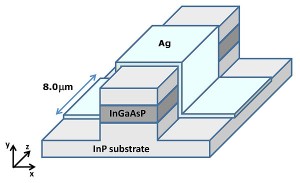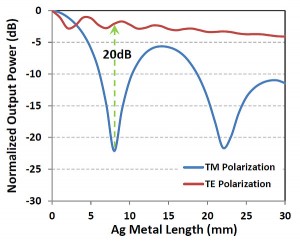Indium Phosphide Plasmonics
- Category: Optics & Photonics
- Tags: Joseph Summers, Rajeev Ram
Surface plasmon polaritons (SPPs) are optical waves that propagate at the interface between a metal and a dielectric, and can provide high optical mode confinement for the realization of compact optical devices [1] [2] . Because SPPs can support polarizations only where the electric field is normal to the metal-semiconductor interface, metals can be patterned onto purely dielectric waveguides to form optical polarizers, where either the TE or TM mode of the dielectric waveguide is resonantly coupled to the SPP [3] [4] .
Here, we describe the design of a compact SPP-based TE polarizer that can be easily integrated with a standard InP-based ridge waveguide (Figure 1). The InP ridge waveguide consists of a 610-nm-thick InGaAsP core (Q=1.44), with InP upper and lower claddings, and the 8-mm-long TE polarizer is created by coating the top and sides of the ridge with a layer of Ag, allowing an SPP mode to be supported at the top Ag-InP interface.
The polarizer works by removing TM polarized light from the semiconductor ridge via resonant coupling to the TM mode of the SPP. After light is fully coupled to the SPP, the Ag layer is abruptly terminated, allowing the light to radiate into unguided modes. Due to the large absorption loss of the SPP-mode (~0.8dB/mm), resonant coupling from the semiconductor ridge mode is sensitive to the coupling strength and the relative propagation losses of the symmetric and antisymmetric coupled waveguide supermodes. If the InP upper cladding thickness is varied, the coupling strength can be adjusted to achieve critical coupling, where the propagation losses of the ridge-SPP supermodes are equal. For this waveguide geometry, critical coupling and optimal power transfer to the SPP mode occurs at an upper cladding thickness of 280 nm, enabling a compact device length of 8 mm, 20 dB polarization extinction, and 2 dB insertion loss at 1550 nm (Figure 2).
- Figure 1: Schematic of the resonantly-coupled Ag-InP SPP waveguide polarizer.
- Figure 2: Eigenmode expansion method simulations show that the polarizer should provide 20 dB of polarization extinction and 2 dB of insertion loss for a device length of 8 μm (λ = 1550 nm).
- W. L. Barnes, A. Dereux, and T. W. Ebbesen, “Surface plasmon subwavelength optics,” Nature, vol. 424, pp. 824-830, Aug. 2003. [↩]
- S. A. Maier and H. A. Atwater, “Plasmonics: Localization and guiding of electromagnetic energy in metal/dielectric structures,” Journal of Applied Physics, vol. 98 no. 011101, July 2005. [↩]
- C.-H. Chen and L. Wang, “Design of finite-length metal-clad optical waveguide polarizer,” IEEE Journal of Quantum Electronics, vol. 34, no. 7, pp. 1089-1097, July 1998. [↩]
- W. Johnstone, G. Stewart, T. Hart, and B. Culshaw, “Surface plasmon polaritons in thin metal films and their role in fiber optic polarizing devices,” IEEE Journal of Lightwave Technology, vol. 8, no. 4, pp. 538-544, Apr. 1990. [↩]

